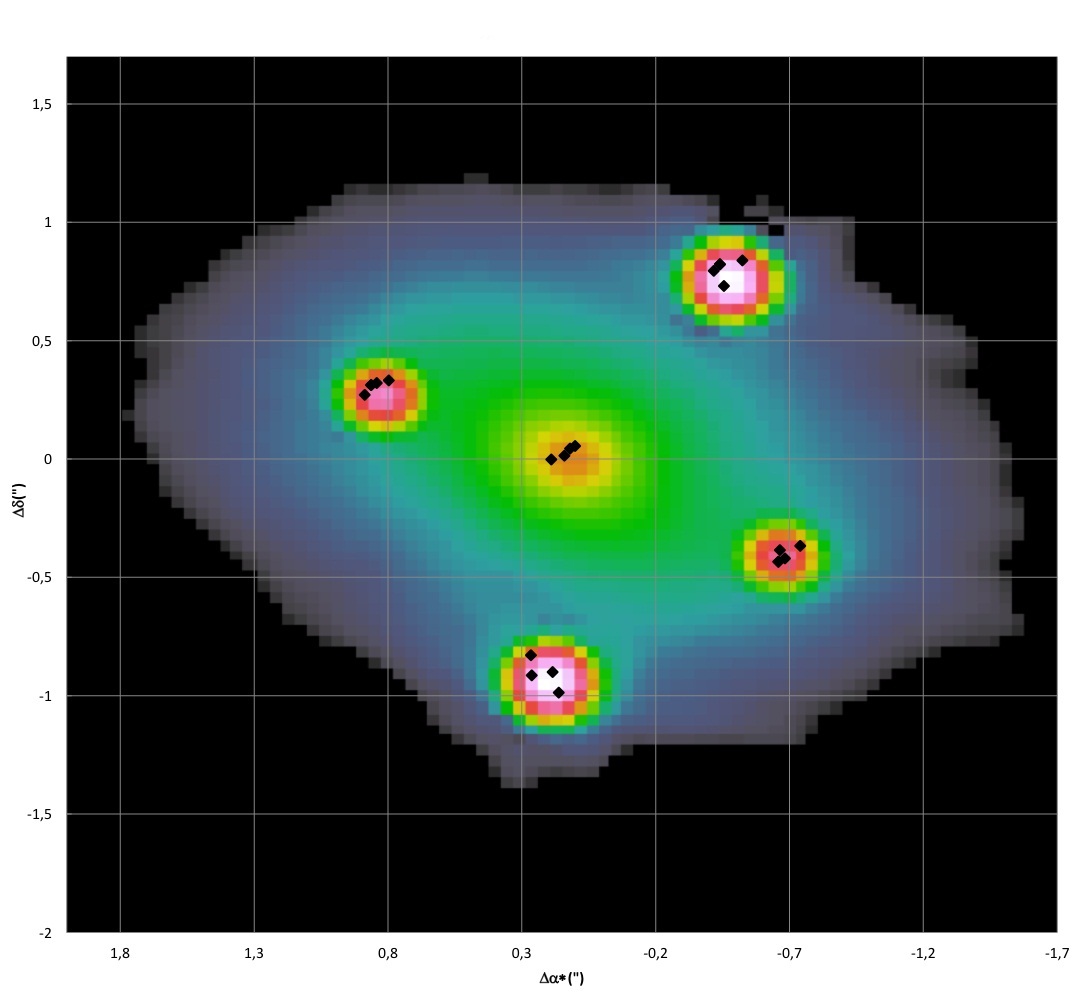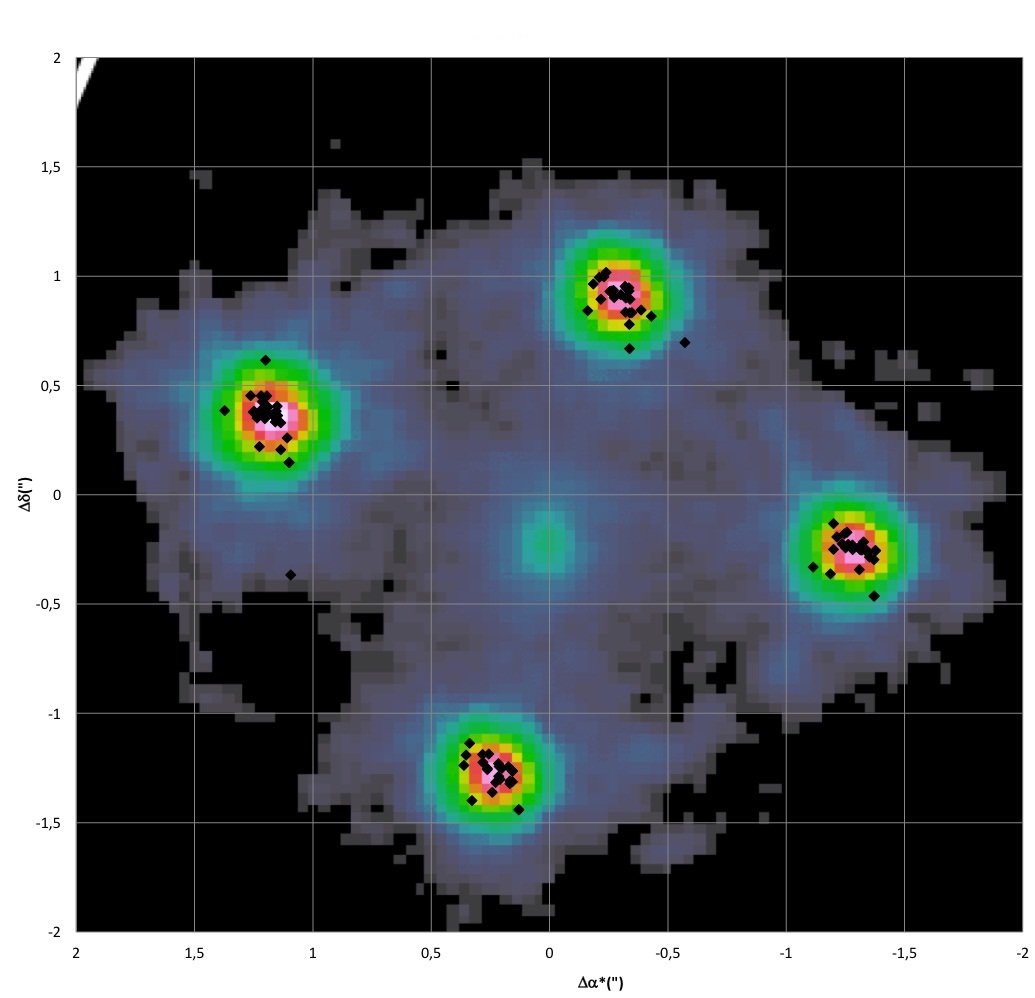IoW_20150409 - Gaia
Image of the Week |
|||
Gaia honours Einstein by observing his Cross |
|||
Q2237+030 |
HE0435-1223 |
||
 |
 |
||
| The Einstein Cross (left) and HE0435-1223 (right) with Gaia astrometric positions placed over HST images. Gaia's on-board system was able to detect four images of the distant quasar in both cases and the intervening lens at the middle of the Einstein Cross. The positions are supplied by the Gaia Initial Data Treatment in a routine mode, with a very preliminary attitude determination. The magnitude of the images ranges from 17 to 19 and the astrometric accuracy of each position in this preliminary reduction is around 100 mas. It will be much improved during the global astrometric processing where spacecraft attitude will also be solved together with the source astrometry. | |||
|
2015 is the International Year of Light and marks an important milestone in the history of physics with the one-hundredth anniversary of Einstein's Theory of General Relativity. Having the ability to test some of its aspects to an unprecedented accuracy, Gaia will probe the tiny deviations predicted by General Relativity in our solar system. However, the satellite will also see other evidence at work such as gravitational lensing shown in the images of the so-called Einstein Cross, discovered in 1985 (Q2237+030), and of a very similar one (HE0435-1223), discovered in 2002. Gravitational lensing was postulated by Einstein as a consequence of light bending in a gravitational field, although it was not seen until 1979 with the observation of two identical quasars, the Twin Quasars, located in the same direction with the same redshift. The images above show the individual measurements of two outstanding instances of gravitational lensing, each with four lensed images of a distant quasar. Data have been collected by the Gaia astrometric detector over the last few months and have been processed with the nominal pipeline, without paying particular attention to the peculiarities of the sources. In both cases, the four images, closely packed in a square of less than two arcsec side, have been recorded as four independent sources at every passage of the system in the Gaia Fields-of-View (FOVs). The core of the foreground galaxy is also seen near the centre of the Einstein Cross and was measured as if it were a star, while it was not detected in HE0435-1223. However, we know that since the on-board detection was done successfully, more data has been sent to the ground and small field images are available, but have not yet been analysed. In both systems, the distant light source is a quasar, a very compact galaxy located at a distance of about 10 billion light years (z=1.7) while the lensing galaxy is much closer to us, but still several 100 Mpc away. The quasar, the galaxy and the observer are almost perfectly aligned (within 50 mas), causing the quasar light ray to pass through the galactic bulge that bends the rays, eventually producing the four images when reaching the Earth. Using the coordinates of the quasars, the orbit of Gaia and the nominal attitude, it was possible to predict accurately (within 0.5 s) the crossing times through the Gaia FOVs and then locate the relevant observations among the 40 million similar observations acquired by Gaia on an average day. The Initial Data Treatment developed by a DPAC team in Barcelona (and run at ESAC) produces every day a very preliminary, and crude for Gaia standards, astrometry and photometry of all the sources detected on-board. These are the positions plotted in the images with the corresponding HST images in the background. The magnitudes of the individual images range from 17 to 19. As we can see, the repeated observations collected over several months are very consistent and a straight combination yields already an absolute position of each image with an accuracy of about 50 mas for the Einstein Cross and better for the second source. This will improve when more data are received and with the global astrometric solution and the final spacecraft attitude. By the end of 2015 there will be 9 new observations of Q2237+030 and 16 for HE0435-1223. This early inspection of Gaia data proves that the on-board detector performs very well and can distinguish individual faint point sources within a second of arc of each other and carry out independent measurements at nominal accuracy. It is expected that Gaia will observe most of the about 100 known multi-imaged lenses and discover more around known and newly discovered quasars. All the images of these sources will be combined and systematically screened over an area of a few arcseconds square to detect further small images, possibly too faint to be seen in Gaia's standard acquisition mode.
credits: ESA/Gaia/DPAC/Christine Ducourant, Jean-Francois Lecampion (LAB/Observatoire de Bordeaux), Alberto Krone-Martins (SIM/Universidade de Lisboa, LAB/Observatoire de Bordeaux), Laurent Galluccio, Francois Mignard (Observatoire de la Côte d'Azur, Nice) [Published: 09/04/2015] |
|||
- Removed a total of (14) style text-align:center;
- Removed a total of (7) style text-align:justify;
- Removed a total of (1) border attribute.
- Removed a total of (1) cellpadding attribute.
- Removed a total of (1) cellspacing attribute.
Image of the Week Archive
- Removed a total of (1) border attribute.
- Removed a total of (1) cellpadding attribute.
- Removed a total of (1) cellspacing attribute.








































 Sign in
Sign in
 Science & Technology
Science & Technology
